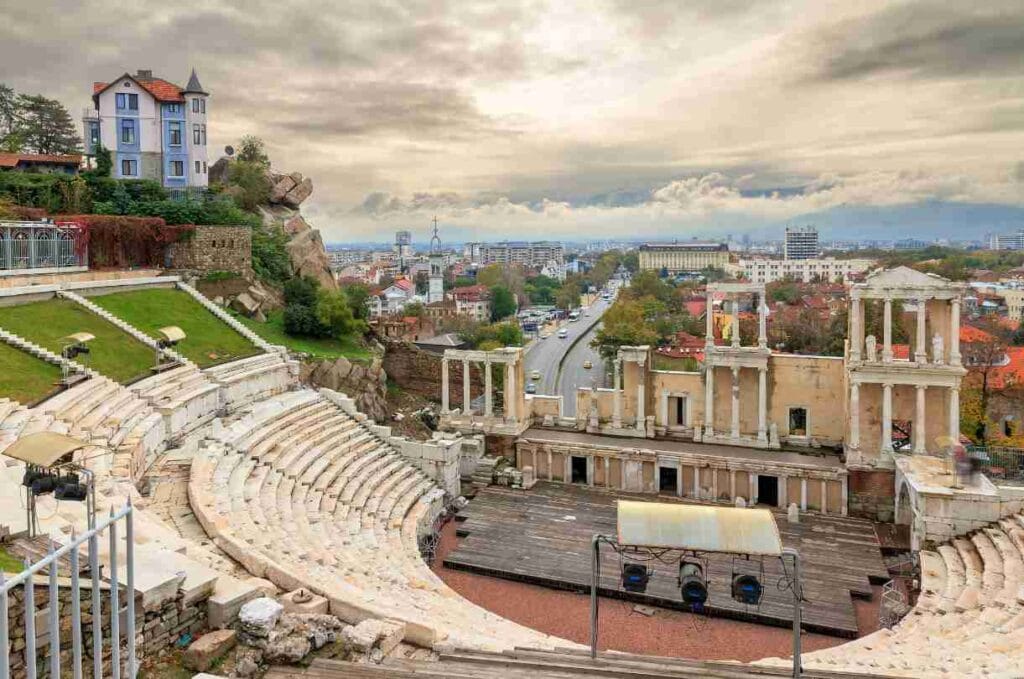Visiting the Rila Monastery feels like stepping into a sacred painting. With its majestic mountain backdrop, intricate frescoes, and an air of tranquility, it’s one of those rare places where history, spirituality, and nature meet in perfect harmony. Having been there three times, I can confidently say it’s magical in every season—but if you truly want to experience its full charm, visit in autumn. Trust me, the golden hues of the surrounding forests will leave you breathless.
So grab your hiking boots, camera, and a hearty appetite (you’ll understand why soon), and let’s explore this incredible gem in Bulgaria’s southwest.
Travel Tips for the Rila Monastery: Planning Your Visit Like a Pro
Before diving into the experience, let’s talk logistics.
- Getting There:
- If you’re driving, the monastery is about 2 hours from Sofia. The road is scenic but winding, so take your time and enjoy the journey.
- Public transport options include buses to the nearby town of Dupnitsa, followed by a local minibus or taxi to the monastery.
- Best Time to Visit:
- While the monastery is beautiful year-round, autumn is the crown jewel. The forests surrounding the area transform into a kaleidoscope of oranges, reds, and yellows, creating a postcard-perfect setting.
- What to Pack:
- Comfortable shoes (you’ll want to explore the surrounding trails).
- A light jacket, as mountain weather can be unpredictable.
- Cash for parking, food, and souvenirs, as card payments aren’t always accepted.
- Pro Tip: Avoid weekends and public holidays if you can. The Rila Monastery is a popular spot, and its peaceful atmosphere is best enjoyed without large crowds.

Accommodation Near Rila Monastery: Where to Stay
Back in the day, my first trip to the Rila Monastery involved a no-frills guesthouse that came with a side of creaky beds and overly chatty landlords. But the charm of the place more than made up for it. Over the years, I’ve explored a range of options, and here’s what I recommend:
- On a Budget: The monastery itself offers basic rooms for about €10–€15 per night. While it’s no five-star experience, waking up to the sound of church bells in a centuries-old complex is priceless.
- Mid-Range: Guesthouses like Tsarska Bistritsa Lodge or nearby family-run hotels offer cozy rooms starting at €25–€40 per night. Many include homemade breakfast with local treats like mekitsi (fried dough).
- Luxury: For those seeking more comfort, hotels in Sapareva Banya (known for its hot springs) or Borovets ski resort provide upscale options within a 30–40 minute drive. Prices range from €50–€120 per night.
What Food Can You Eat Near Rila Monastery?
You don’t just visit Rila Monastery for the history and views—the food is part of the pilgrimage too. Bulgarian mountain cuisine is hearty, flavorful, and perfect for refueling after a day of exploration.
- Must-Try Dishes:
- Bob Chorba: A traditional bean soup, slow-cooked to perfection. The monastery’s version is legendary, and for good reason.
- Mekitsi: These fried dough treats, served with powdered sugar, jam, or honey, are a local favorite. Pair them with a cup of herbal tea for a perfect snack.
- Trout: Freshly caught from the mountain streams, grilled trout is a must for fish lovers.
- Sheep’s Yogurt: Creamy and rich, it’s a taste of the mountains in every spoonful.
- Dining Options:
- The Monastery Bakery: Famous for its mekitsi, this little spot inside the monastery complex is perfect for a quick bite.
- Local Taverns: A short drive from the monastery, you’ll find family-run taverns serving homemade dishes. Prices are reasonable, with a meal costing around €8–€15.
Cultural and Historical Significance of Rila Monastery
The Rila Monastery isn’t just a pretty face—it’s a UNESCO World Heritage Site and one of Bulgaria’s most treasured landmarks. Founded in the 10th century by St. Ivan of Rila, it has been a spiritual and cultural hub for over a thousand years.
Highlights to Explore:
- The Nativity Church:
The heart of the monastery, this church is a masterpiece of Bulgarian Renaissance art. The frescoes, painted by the legendary Zahari Zograf, are so detailed you could spend hours admiring them. - The Tower of Hrelja:
Dating back to the 14th century, this defensive tower is the oldest structure in the complex. Climb to the top for panoramic views of the monastery and surrounding mountains. - The Monastery Museum:
Housing priceless artifacts, manuscripts, and religious icons, the museum offers a fascinating glimpse into Bulgaria’s history and spirituality. - The Library:
With over 250 manuscripts dating back to the Middle Ages, the library is a treasure trove of knowledge and artistry.
Prices for Staying and Visiting Rila Monastery
One of the best things about Rila Monastery is how budget-friendly it is. Here’s a quick breakdown of costs:
- Entrance Fee: The monastery itself is free to enter, but the museum charges a small fee (around €4).
- Accommodation: Dormitory-style rooms within the monastery cost €10–€15, while guesthouses nearby start at €25.
- Parking: Expect to pay about €2–€3 for parking near the monastery.
- Food: A hearty meal at a local tavern costs around €8–€15, while snacks like mekitsi are just a few euros.
Why Autumn is the Best Season to Visit
Let me paint you a picture: Crisp mountain air, golden leaves blanketing the forest floor, and the monastery’s red-and-white striped walls glowing in the autumn sunlight. It’s a scene straight out of a fairy tale.
The trails around the monastery, like the path to St. Ivan’s Cave, are especially enchanting in autumn. You’ll find fewer crowds, making it the perfect time for quiet reflection or simply soaking in the natural beauty.

Final Thoughts: Rila Monastery, Then and Now
Every time I visit the Rila Monastery, I’m struck by its timelessness. While the world around it changes, the monastery remains a sanctuary of peace, beauty, and history. Whether you’re a history buff, nature lover, or spiritual seeker, this magical place has something to offer.
So pack your bags, plan your trip, and prepare to fall in love with Bulgaria’s spiritual heart. And don’t forget to bring your appetite—those mekitsi aren’t going to eat themselves!
Booking work best in Bulgaria



